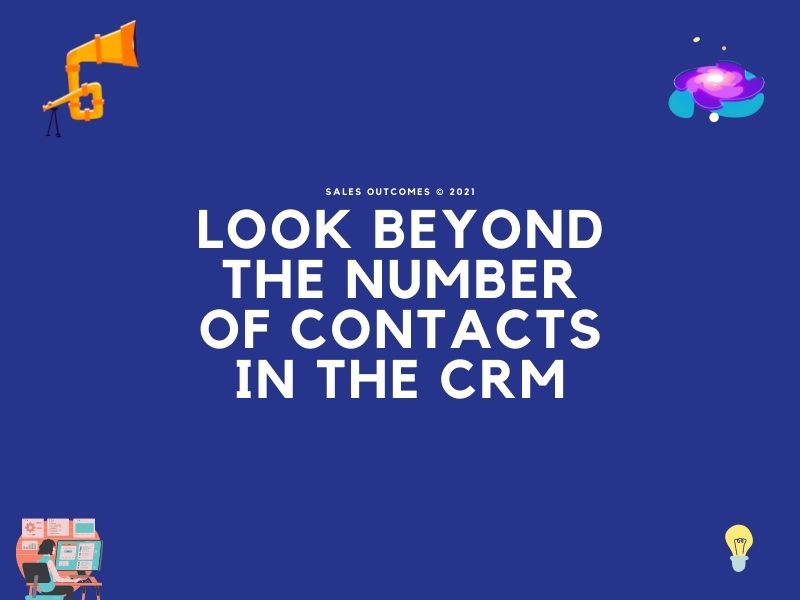Considerations for thinking differently about managing lead and contact CRM records:
-
- Users tend to import more contacts than they can follow-up on
- Company before individual
- They’ve left the company
- Titles can be deceiving
- Meaningful activity is a leading indicator
- Lack of alignment with marketing
The number of CRM leads and contacts is a metric that doesn’t mean much about the sales and marketing teams’ ability to grow and retain revenue. Increasing the number of CRM leads and contacts may be a hindrance to executing the go-to-market plan.
Many marketing and sales organizations are determined to increase CRM lead and contact records through tools such as LinkedIn Navigator, ZoomInfo, InsideView, Hoover’s, etc. Yes, these tools can assist in identifying individuals to engage. However, organizations should think through the contact and lead record management lifecycle before adding more records to the CRM.
If your organization hasn’t established a governance process to maintain (update, refresh, enrich, segment) existing lead and contact records, adding new records will contaminate data quality and hygiene, which will, in turn, erode the organization’s confidence in the CRM.
Here are considerations for thinking differently about managing lead and contact CRM records:
1. Users tend to import more contacts than they can follow-up on
If a user downloads the VP of Finance from one of the tools, they may download the entire executive team. Guess what? Marketing might decide to include the executive team in a marketing campaign. Is it possible that one or more individuals might send emails to spam/junk and contaminate future outreach efforts? Users should limit record imports to those they can reasonably engage in a month.
2. Company before individual
Segmentation at the company/account level – Industry, type, employee range are attributes that company’s use to target sales and marketing efforts. Make sure your segmentation attributes and related quality and hygiene processes are in place. Otherwise, you’ll be adding records without details to segment and target sales and marketing efforts.
3. They’ve left the company
There is an upward of 20% annual turnover in large organizations, so you must be able to identify individuals who have left a company. Users need to identify individuals who have left as soon as they know, and marketing needs to identify hard bounces from email campaigns. We recommend a checkbox on the lead and account record. Don’t delete these records, or you’ll lose the historical perspective of who your teams may have engaged.
4. Titles can be deceiving
Sure, CEO and CFO titles are unambiguous. How about VP Automotive or Director of Retail? Are they in operations or sales? Is the VP part of the inner leadership circle? What if it’s a Japanese company where the manager role may hold significant authority? Users need a Title Category (Job Category or similar) field to classify their functional role. Over time, this field helps sales and marketing target sales effort and communications better and minimize wasted effort.
5. Meaningful activity is a leading indicator
Sales and marketing activity against a lead or contact take many forms. Ever sent someone dozens of unopened emails or completed 20 calls that went to voicemail? How would you compare that type of effort versus sending one email that gets opened and a subsequent email exchange? How about an existing customer versus a prospect? Once an organization determines what activities are meaningful, it can assess contact quality.
6. Lack of alignment with marketing
Marketing and sales typically approach lead and contact management differently. Marketing will typically focus on email open and click rates, but not salesperson engagement or activity. Depending on the organization, marketing may be tasked with email marketing to warm up sales outreach for records that sales have not contacted. For others, marketing may email records that are in the engagement process. Both approaches have value. However, if marketing isn’t paying attention to CRM record sales activity, they miss the chance to accelerate meaningful lead and contact engagement.
Before importing additional lead and contact records from the tools mentioned, organizations should establish a governance process to manage existing records to maximize the value for the sales and marketing teams.
With governance in place, importing records from external tools will strengthen CRM lead and contact record quality. More robust CRM use and adoption will soon follow.
For more Tips to Improve CRM Management, Click Here to Subscribe to Two-Bullet-Tuesday





